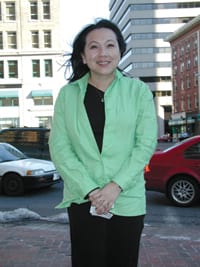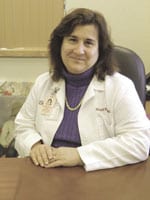Foreign Concept Health Project Provides A Bridge
Thu Pham has several success stories she tells to illustrate the role of the Vietnamese Health Project in Springfield.
One involves a Vietnamese man, jailed in Washington D.C. after being involved in a disturbance. He suffered from mental illness and would not be released until proper care had been secured for him. A few days later, Pham’s phone rang in Springfield, and she put the mechanisms in place to find the man the proper care and assistance in Western Mass.
He’s now doing well and still living locally, she said.
Another story details a woman with a large family, who found out she was pregnant but was unsure how she would deal with the added expense, responsibility, and even telling her husband. The health project saw her through a few difficult months, making sure the pregnancy was safe.
Now overjoyed with their youngest child, a 10-year-old daughter on the honor roll at school who will receive First Communion this spring, the proud parents recently called Pham to invite her to the ceremony.
“These are the stories that keep us going,” said Pham, who has led the Vietnamese Health Project (VHP) since 1991, when it was federally funded. “It’s stressful work. But, when you can see the people you’re helping every day, you think, ‘well, so far so good.’”
A Telling Tale
Pham herself is one of the VHP’s success stories; she has been recognized for her work with the Vietnamese community, receiving the Public Health Luminary Award from the City of Springfield in 2003. She doesn’t tout the recognition, but told The Healthcare News that she, too, understands the frustration and fear that can arise from seeking health care in an unfamiliar culture, and that makes her work that much more important.
Pham arrived in the U.S. after escaping Vietnam by boat. She first settled in Michigan, but her friend, Hong Luong, found work in Springfield, and soon asked Pham to join her. Luong and Pham became the first two Vietnamese health workers in the area, assisting a population that began to grow after the Homecoming Act was passed in the late ‘80s, allowing Asian-Americans living in Vietnam safe harbor in the U.S.
The Vietnamese population continued to grow, Pham said, because it was one of the few places in the country where immigrants and refugees could find employment and a place to live more easily than in other locations.
In some ways, nothing has changed – the needs of the Vietnamese community have not lessened, and Pham still directs a staff of two, one full time, the other part time, that relies on partnerships within the community and some volunteers.
The program has since lost its federal funding, but now receives support from the Sisters of Providence Health System, continues to provide a wide array of services to Springfield’s Vietnamese population, which currently hovers around 7,000. The VHP will celebrate its long run this April with an anniversary celebration.
Statistics back up Pham’s belief that the VHP is indeed addressing the needs of the Vietnamese population in Springfield; 90{06cf2b9696b159f874511d23dbc893eb1ac83014175ed30550cfff22781411e5} of Vietnamese babies in the area are now delivered at the Mercy Family Life Center each year, with the assistance of the VHP, and over the past three years, 5,680 case-management encounters were documented.
The program addresses a number of issues facing the population: cultural differences, economic concerns, and language barriers, to name a few.
“We act as a bridge between the Vietnamese people and health care,” Pham said, adding that in the literal sense, that means accompanying people to the doctor’s office, helping them enroll in MassHealth, or supporting them through pregnancies and finding appropriate pediatric care.
The Rest of the Story
It can also mean increasing awareness of ongoing health issues and advocating for the health of employees within Vietnamese-owned businesses, such as the more than 300 nail salons in the Greater Springfield area – 90{06cf2b9696b159f874511d23dbc893eb1ac83014175ed30550cfff22781411e5} of which are owned by Vietnamese individuals.
But the broader goal is to create an understanding and a respect between the health care community and one of the largest populations it serves within the City of Springfield.
Cultural concerns play a very real role in the successful delivery of health care, Pham explained, and not just because of language differences. For many Vietnamese people, annual check-ups are a foreign concept, and hospitals are looked at as places to die.
“A flu or a cold is sometimes seen as a bad spirit,” Pham offered as another example. “And antibiotics can be found on the black market in Saigon – you don’t have to go to a doctor for them.”
In addition, most clients don’t speak English or don’t have a full grasp on the language.
But even those who speak perfect English, or have lived here for some time need help, said Pham, adding that the VHP is charged with not only educating the Vietnamese population, but also the health care providers that treat them.
Consider the long-standing Vietnamese traditions regarding pregnancy – culture dictates that Vietnamese women be kept in a quiet, warm setting and drink only warm liquids. The VHP works with obstetrics care providers in the Valley to make them aware of this point, and in turn treat the woman giving birth accordingly.
“Here, it is a brand new system and very different for a lot of people whose cultural beliefs are very strong. We go door-to-door to let them know we are here to help, and offer health education and resources to make the transition easier. Because of that, we have become well known in the community; people know we’re here.”
She noted that the endeavor is not just altruistic, but makes good business sense, too. By educating the Vietnamese population about Western medicine and the resources that are available here, the VHP is helping to create a healthier community, and thus bring down the cost of health care to everyone.
“The more people understand about illness the better they will handle it,” Pham explained. “Community health workers help people understand illness and how to treat it, when to get prescriptions, when to go to the doctor. They also help people understand the system in place so not everyone goes to the emergency room when they are sick – that reduces costs for the client and for the area hospitals, so it’s good for everyone.”
Small Rewards
Pham said the community’s response to the VHP is her greatest reward, constantly reminding her of the project’s importance. The affirmations are sometimes small gestures, like the parents of the 10-year-old honor student’s invitation to their daughter’s First Communion.
Often, though, they are quite big; Pham’s friend Luong recently passed away after a battle with cancer, and her memorial service was attended by hundreds of former clients.
“There were so many people there she had helped,” said Pham. “And they remembered. That’s what keeps you going.”



Comments are closed.